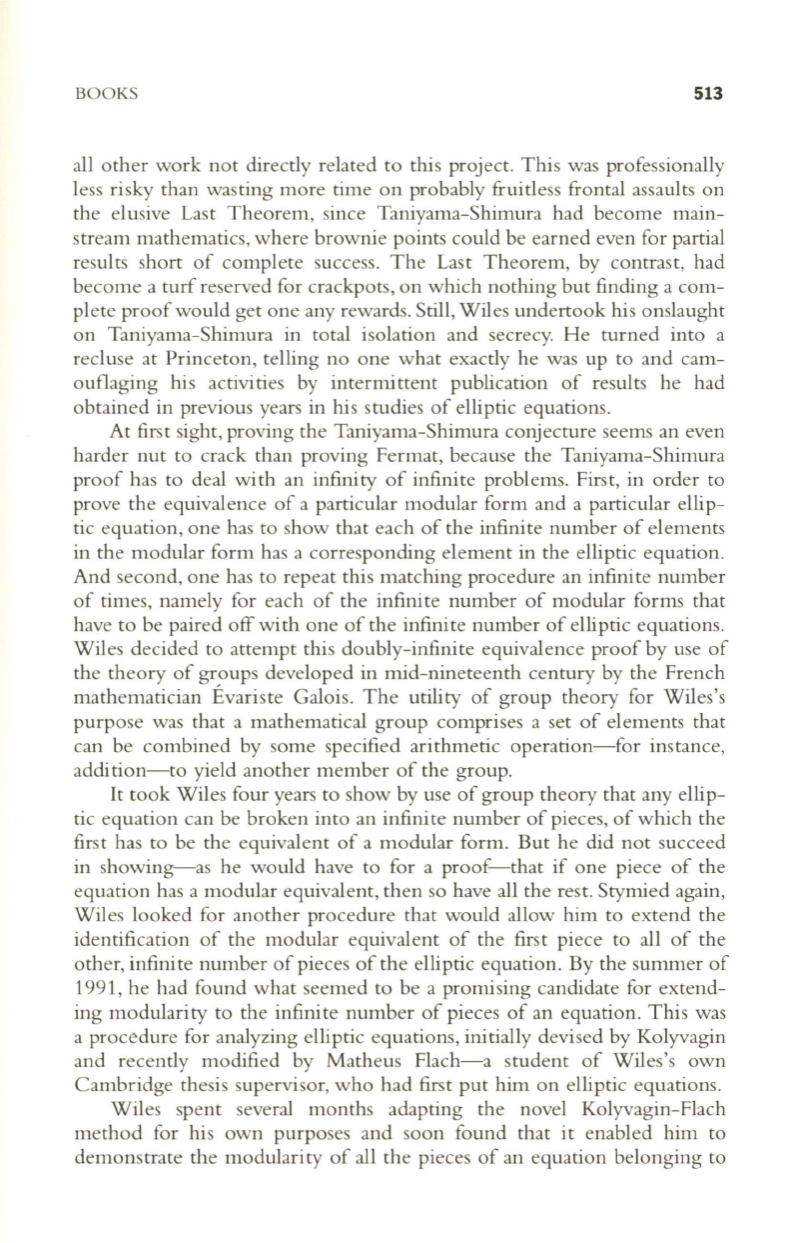
BOOKS
513
all other work not directly related to this project. This was professionally
less risky than wasting more time on probably fruitless frontal assaults on
the elusive Last Theorem, since Taniyama-Shimura had become main–
stream mathematics, where brownie points could be earned even for partial
results short of complete success. The Last Theorem, by contrast, had
become a turf reserved for crackpots, on which nothing but finding a com–
plete proof would get one any rewards. Still, Wiles undertook his onslaught
on Taniyama-Shimura in total isolation and secrecy. He turned into a
recluse at Princeton, telling no one what exactly he was up to and cam–
ouflaging his activities by intermittent publication of results he had
obtained in previous years in his studies of elliptic equations.
At first sight, proving the Taniyama-Shimura conjecture seems an even
harder nut to crack than proving Fermat, because the Taniyama-Shimura
proof has to deal with an infinity of infinite problems. First, in order to
prove the equivalence of a particular modular form and a particular ellip–
tic equation, one has to show that each of the infinite number of elements
in the modular form has a corresponding element in the elliptic equation.
And second, one has to repeat this matching procedure an infinite number
of times, namely for each of the infinite number of modular forms that
have to be paired off with one of the infinite number of elliptic equations.
Wiles decided to attempt this doubly-infinite equivalence proof by use of
the theory of groups developed in mid-nineteenth century by the French
mathematician Evariste Galois. The utility of group theory for Wiles's
purpose was that a mathematical group comprises a set of elements that
can be combined by some specified arithmetic operation-for instance,
addi tion-to yield another member of the group.
It
took Wiles four years to show by use of group theory that any ellip–
tic equation can be broken into an infinite number of pieces, of which the
first has to be the equivalent of a modular form. But he did not succeed
in showing-as he would have to for a proof-that if one piece of the
equation has a modular equivalent, then so have all the rest. Stymied again,
Wiles looked for another procedure that would allow him to extend the
identification of the modular equivalent of the first piece to all of the
other, infini te number of pieces of the elliptic equation. By the summer of
1991, he had found what seemed to be a promising candidate for extend–
ing modularity to the infinite number of pieces of an equation. This was
a procedure for analyzing elliptic equations, initially devised by Kolyvagin
and recently modified by Matheus Flach-a student of Wiles 's own
Cambridge thesis supervisor, who had first put him on elliptic equations.
Wiles spent several months adapting the novel Kolyvagin-Flach
method for his own purposes and soon found that it enabled him to
demonstrate the modularity of all the pieces of an equation belonging to


